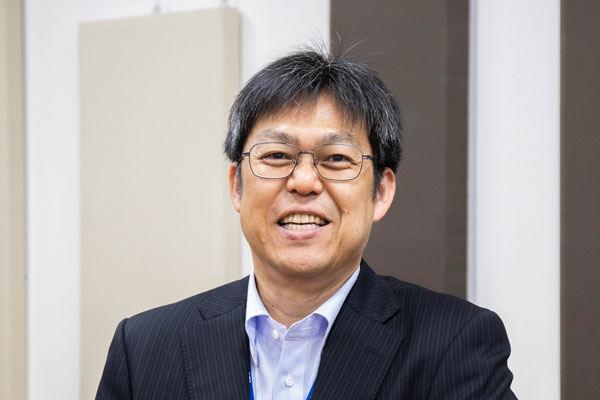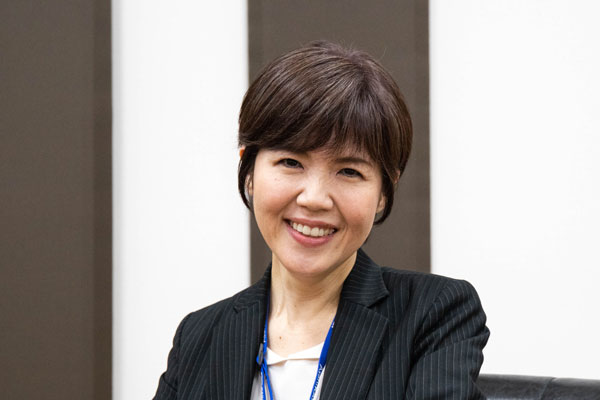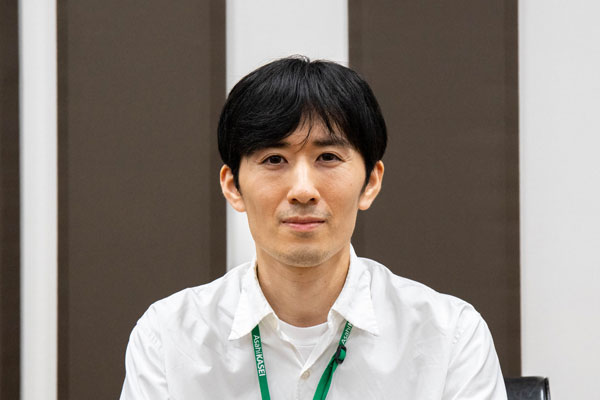VELVET SOUND pioneers a new era of sound
December 2022
Inside Story #04
The new flagship DAC AK4499EX and AK4191 that adopt the latest high-quality sound technology and a completely separated digital / analog circuitry solution.
Concept Video
INSIDE
In 2022, the new flagship stereo D/A converter (DAC), the VELVET SOUND | VERITATM AK4499EX was newly released. The AK4499EX, with the "EX " in its name meaning "Exceed", has world-class noise and THD characteristics that exceed those of the former flagship AK4499. Combined with the AK4191, which performs digital processing, it is a completely separate digital/analog solution that delivers a level of sound quality never experienced before.
We interviewed the designer about the story behind the development of this product.
A smooth signal path is achieved by separating digital and analog signals.
The combination of AK4191 and AK4499EX, which form a separate DAC configuration, has the following three features in terms of specifications.
1. Completely separate digital and analog configuration based on the latest design technology
2. "DWA Routing Technology" that contributes to improved S/N characteristics
3. Realization of both support for ultra-high specification formats and simple operation
(Nakamoto)
The first is the configuration where the digital and analog sections are completely separated using the latest design technology. The second is the achievement of the world's best analog characteristics. The third is the two-chip solution that achieves the ultra-high-rate resolution at the highest level with simple operation.
The AK4499EX incorporates a new technology, DWA Routing Technology, which improves noise immunity compared to that of the AK4499.
The AK4499EX is a 2-channel chip configuration with a per-channel signal-to-noise ratio of 135dB and a distortion characteristic of -124dB, a 1dB improvement over the AK4499's per-channel signal-to-noise ratio of 134dB. On the other hand, the AK4191, which is responsible for digital processing, supports input up to 1,536kHz/64-bit PCM & 44.8MHz DSD, and achieves an oversampling rate of 256x. It also achieves 150dB of stopband attenuation, which is the amount of suppression of the digital filter.
(Nakamoto)
First of all, there is the merit of the separate configuration. Noise interference is unavoidable in a single-chip configuration even if every possible means is taken because analog and digital devices exist on the same silicon wafer. In the separate configuration, the noise interference path is completely cut off, eliminating the impact of noise and improving the audible noise characteristics.
However, it is not just a matter of separating the two. This solution is developed by taking care of noise from various angles in the core section that performs the D/A conversion using the latest sound quality design technology. And by optimizing the impedance, we were able to achieve a speedy and dynamic sound with excellent responsiveness. The impedance is designed to suit the process that is used in this project and it is not just a matter of having a low impedance.
The main reason why the AK4499 applies a 4-channel specification, while the AK4499EX applies a 2-channel specification is due to the natural layout on the board, which comes from the pin layout. The AK4499 has 128 pins and the AK4499EX has 64 pins, which is half the number of pins and at the same time, the boundary between the digital and analog domains is clearly defined, making it easier to wire the board and optimize the signal flow, contributing to the pursuit of an even higher sound quality and ideal sound.
(Sato)
The AK4499 applies a 4-channel specification, but we wanted to create symmetry in the layout between the channels. We wanted to make the signal flow natural, which is what we were aiming for, and it was also requested by the set manufacturers we were supplying them to. If digital enclaves were created, separation on the board becomes impossible in spite of our preference.
If that is the case, it would be acceptable to truncate the 4-channel specification. Rather, by lowering the noise per channel firmly, it would be easier to draw lines on the board, whether each channel is discrete or bundled and parallelized. A natural layout will enhance usability.
"DWA Routing Technology" that enables further property improvements
Regarding the second point of realizing the world's best-in-class analog characteristics, Mr. Chubachi explained his specific focus and new technology, DWA Routing Technology.
(Chubachi)
The pursuit for the world's best-in-class analog characteristics depends on low noise and low distortion. To pursue the ideal sound, we have reduced the true noise characteristic of the DAC. In particular, based on the premise that the S/N characteristic per channel is the true circuit characteristics, we have improved them by 1dB compared to the AK4499. The distortion characteristic is -124dB, the same as the AK4499, which is one of the smallest in the world.
It was one of the most difficult design challenges to achieve this characteristic due to the change in the fab. By understanding the other companies' fabs and figuring out where to make changes, we were able to achieve -124dB by combining the low distortion technology we have been working on for a long time.
The 1dB improvement in the S/N characteristic is largely due to the new DWA Routing Technology. To achieve ultra-low noise, high matching accuracy is required for the numerous resistor elements that are used to generate the current in a current-output DAC. Generally, a technique called dynamic element matching is used to reduce the apparent mismatch by averaging resistors thoroughly.
The DWA of DWA Routing Technology stands for Data Weighted Average, and this technology, based on dynamic element matching, improves S/N by reducing the effect of mismatch due to manufacturing factors. The reduction of noise at various amplitudes, including no signal and small signals seems to have improved the reality and detailed expression of weak signals over the AK4499.
The production of chips of this separate DAC configuration of the AK4191 + AK4499EX as well as the AK4490R and AK4493S that were introduced this year will be consigned to other companies' fabs. Until then, there must have been some advantages and particularities that could only be achieved by an in-house fab, but how has this issue has been overcome?
(Nakamoto)
We had the advantage of having a semiconductor fab, but I feel that our accumulated knowledge was more significant. This knowledge allows us to know how to use any fab anywhere. As having an in-house fab, we had gained in-depth knowledge through repeated interactions with our own process engineers. We have the design know-how to say, ‘This process is characterized in this way, so we need to take these countermeasures’. We have members who were involved in process development at the Nobeoka plant in-house and the knowledge we have gained through repeated exchanges is a very significant asset.
That is why we are confident that no matter where we make the product, it will be fine. When we use a new fab, we are surprisingly able to determine, ‘This is a risky fab.’ or ‘This is an easy-to-use fab.’
(Chubachi)
DWA Routing Technology has also been developed through vigorous communication with process engineers with the assumptions and judgments on the incidents that cannot be predicted only on paper or with fab data. This technology was accomplished through the cooperation from the process engineers and circuit designers.
Support for ultra-high-specification formats and countermeasures against jitter
The third point, a two-chip solution that supports ultra-high-resolution sound sources while providing simple operation, largely benefits from the AK4191's advanced digital processing unit. Supporting input up to 1,536kHz/64-bit PCM & 44.8MHz DSD, the AK4191 will be able to handle higher-rate sound sources without any problems when they are introduced in the future.
This two-chip solution offers a high functionality including automatic PCM/DSD mode switching, sampling frequency mode, and data stream rate switching. The AK4499EX is also equipped with a control signal generation function that automatically performs mute control, realizing POP noise control at the switching of a sound source. In addition, a major advantage in terms of sound quality is the asynchronous operation mode, which enables separation of the digital and analog clocks, enabling jitter transmission.
(Nakamoto)
The AK4191 audio interface operates in synchronization with the audio clock and the AK4499EX, which performs D/A conversion as the second stage of the AK4191, can perform high-precision D/A conversion by using a different low-jitter clock. For example, when streaming data is played back, even if the clock rate of the data that is sent and the clock rate of the data to be run in the DAC do not match, high-precision D/A conversion is enabled.
(Chubachi)
During data conversion, unwanted components called image components are also generated. The image components are handled by realizing stopband attenuation capacity of 150dB with the digital filter of powerful computation equivalent to a sampling rate converter. Having this filter in the digital chip also suppresses noise from asynchronous operation, resulting in analog characteristics with no degradation.
 Tomonori Sato
Tomonori Sato
Tomonori Sato, Audio Meister
Marketing & Sales Center, Solution Department 2
 Seiko Makamoto
Seiko Makamoto
Seiko Makamoto, Lead Expert / High Sound Quality Technology
Product Design Center, Product Development Department 1, Group3
 Tetsuya Chubachi
Tetsuya Chubachi
Tatsuya Chubachi
Product Design Center, Product Development Department 1, Group3
The AK4499EX and AK4191 are the result of VELVET SOUND's careful attention to sound, analog characteristics, and functionality, and we hope that many people will experience this new world of sound.
◆ Related Article (Japanese)

